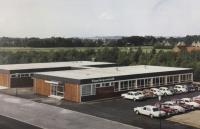 Add My Company
Add My Company
Sign In
KTR History
07-02-2019

The History of the 1960's
The next stop on our trip down memory lane takes us to 1960 Germany; a make-or-break decade in KTR history.
By the 1960’s, the BoWex curved-tooth gear coupling had been in production for nearly a decade, but sales remained stagnant. This was due in large part to reservations surrounding the relatively new nylon material of the coupling. To combat customer hesitations, we sent out samples for customer testing. Although some of the samples turned doubters into customers, not everyone who tried the new material became convinced. These unsuccessful samples led to a loss of capital and prompted our young company to question its place in the market.
Given our significant debts at the time, we seriously considered whether shutting down would be the best option. However, a slight upturn in distribution and temporary aid from our parent company F. TACKE KG, allowed us to cover invoices and salaries and avoid liquidation.
Since we knew we were nearing the end of our rope, we chose to focus on what differentiated us from our competitors, which was our “ordered in the morning, supplied in the afternoon” operating principle. This was the key to our success as our competitors only stocked unbored or pilot bored couplings. By 1963, it was clear that customers were beginning to appreciate our commitment to flexibility in delivery and our turnover more than doubled. We were finally making a profit and by 1965, we reached our first 1 million DM, entirely from our revolutionary BoWex coupling!
Of course, everyone was ecstatic about turning a profit, but that wasn’t enough. We wanted to continue to produce innovative products for our customers. As such, we turned our focus to creating a torsionally flexible coupling solution, which became the ROTEX coupling. Our aim was to create a simple and affordable solution for the latest drives that required more damping and torsional elasticity. We chose a simple three-piece jaw-type coupling with a flexible spider to compensate for shaft displacement. We offered the spiders in yellow, green, and blue. Each colour indicated a different level of shore hardness and subsequent level of torque. Although we recently changed our colour scheme, we still use the same colour coding principle for spider hardness to this day.
The late 1960’s was a time of exploration and expansion. We attended technical fairs in Germany and neighbouring countries as we attempted to make a name for ourselves across Europe. We were even able to open a new office to accommodate our growing workforce as the KTR brand gained momentum. The 60’s were an exciting time in KTR history and we hope you’ll continue to join us as we look back at the tumultuous journey that brought us to where we are today.
For more information on KTR History talk to KTR U.K. Ltd
Enquire Now
List your company on FindTheNeedle.

